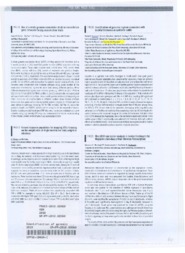Identification of genomic regions associated with backfat thickness in synthetic cattle.
Identification of genomic regions associated with backfat thickness in synthetic cattle.
Autoria: VERONESI, G. B.; MEIRELLES, S. L.; SANTIAGO, A. C.; GROSSI, D. A.; SONSTEGARD, T. S.; YAMAGISHI, M. E. B.; COUTINHO, L. L.; OLIVEIRA, H. N.; ALENCAR, M. M.; REGITANO, L. C. de A.
Resumo: Canchim is a synthetic beef cattle developed in Brazil which have good growth potential and tropical adaptation but suboptimal fat deposition. There are genomic regions associated with fat deposition already described, among them the centromeric region of BTA14. The scope of this work was to identify genomic regions associated with backfat thickness in Canchim (5/8 Charolais + 3/8 zebu) and MA (offspring of Charolais bulls and 1/2 Canchim + 1/2 Zebu cows) populations and to validate the association of haplotypes of the BTA14 with backfat thickness in this population. Thirty animals with extreme phenotypes were genotyped with the 54 K SNP chip, revealing 100 signifi cant SNPs contained in chromosomes 1, 2, 3, 4, 5, 6, 7, 8, 9, 10, 11, 12, 14, 15, 17, 18, 19, 20, 21, 23, 24, 27, 28 and X. Thirty-four SNPs constituted seven chromosomal regions containing 3 or more SNPs located at intervals shorter than 9 Mb and, among these, ten SNPs in BTA 14 were selected for validation. Genotyping in the population was performed by the TaqMan method in families comprising more than 10 individuals with backfat thickness information at the age of 18 months (644 animals). Validation of the BTA14 SNPs revealed two haplotypes, one in the centromeric region and another in the middle region of BTA14, signifi cantly associated with fat thickness, both with additive effects on backfat thickness. Genes located close to these two regions should be further studied to identify potential mutations involved in backfat deposition.
Ano de publicação: 2010
Tipo de publicação: Resumo em anais e proceedings
Unidade: Embrapa Agricultura Digital
Palavras-chave: Beef cattle, Canchim, Gado de Corte, Genomics, Genômica
Observações
1 - Por padrão são exibidas publicações dos últimos 20 anos. Para encontrar publicações mais antigas, configure o filtro ano de publicação, colocando o ano a partir do qual você deseja encontrar publicações. O filtro está na coluna da esquerda na busca acima.
2 - Para ler algumas publicações da Embrapa (apenas as que estão em formato ePub), é necessário ter, no celular ou computador, um desses softwares gratuitos. Sistemas Android: Google Play Livros; IOS: iBooks; Windows e Linux: software Calibre.
Acesse outras publicações
Acesse a Base de Dados da Pesquisa Agropecuária (BDPA) para consultar o acervo completo das bibliotecas da Embrapa.

